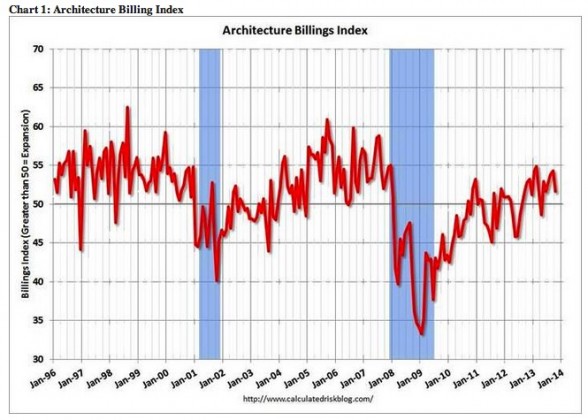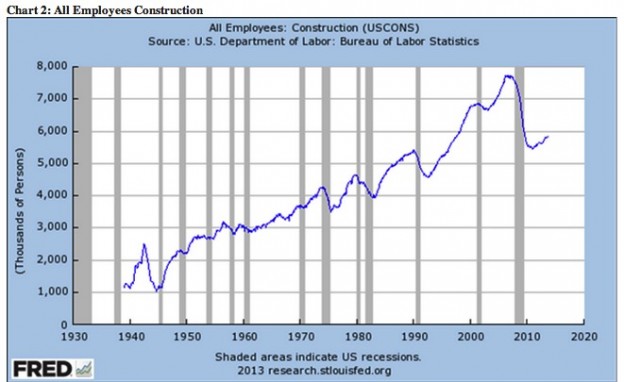“Davidson” submits:
The American Institute of Architects (AIA) reported the October ABI score at 51.6, down from September’s mark of 54.3-see Chart 1: Architecture Billing Index. AIA New Projects Inquiry Index was reported at 61.5 vs. September’s 58.6. Demand for architectural design services is 9mos-12mos ahead of trends in construction activity and forecasted to be positive.
Notice that the data in this series is quite choppy. Many have tended towards treating this data as a precise measure of design demand activity and they issue buys/sells on each wiggle. Like any other economic measure, the ABI does not and can not capture precisely all the design demand of any particular period as all architects are not members of AIA. For those who interpret this data literally that measures above 50 mean Demand is greater than Supply and vice versa means that they must trade frenetically because they view the economy as being ‘on’ one month and ‘off’ another. This is much like a child playing with a light switch, ‘on’-‘off’-‘on’-‘off’…etc.
But, the economy is never ‘on’-‘off’-‘on’-‘off’!
The US economy with our 310mil individuals simply does not have the ability to reverse direction as often as many seem to believe it does. $16trillion of human activity which is roughly where the US Real GDP is today is just way too large to be ‘on’ one month and ‘off’ the next. The choppy patterns so often seen in economic data reflect the fact that economic data can not capture every input for any particular period for any economy. If it were possible to actually capture an exact economic measure at some point in time, by the time the data had been compiled for reporting the inputs for the measure would have changed. Some portion of participants would have retired or otherwise ‘dropped out’ of the sector being measured while new providers had entered with skills more attuned to current demand. Precisely measuring human activity of any sector of interest will always be imprecise! What we do instead is to sample the portion of the economy which we desire to monitor and accept the month-over-month variability as sampling error. Net/net the data will always appear choppy! How we handle this choppiness is to not take any single month as carrying the pertinent information we desire. Instead, we look to the ‘true measure’ as the ‘trend of the data’ which requires several months of contiguous readings.
One can see two trends in the ABI data below. There is a trend from the low point in early 2009 till Jan 2011 which represents a fairly rapid rebound from low levels. A second slower growth trend can be seen in the data from Jan 2011 forward. It appears that a rapid recovery suddenly met a roadblock! We have actually seen something which could account for this in bank lending spreads. The data certainly appears to match the Fed’s Operation Twist and Quantitative Easing programs which one can interpret as resulting in a contraction in bank lending spreads in 2011. 10yr Treasury rates fell from ~3.6% Feb 2010 to below 2% by Jan 2012. One can interpret ABI and other economic data to infer that the Fed stifled lending with its QE type programs because the normal credit spreads did not permit banks receive spreads attractive enough to offset the risks perceived. Of the many stories which reflected the impact of low rates is the story of financing a Hudson Yards project by Related Cos. A consortium of banks could not agree on financing $350mil of the Hudson Yards project which they felt carried too much risk. Eventually Related Cos turned to Barry Sternlicht, a private equity real estate entrepreneur, who agreed to finance entire $350mil in a deal which took less than 48hrs to complete, Wall Street Journal-Barry Sternlicht finances Hudson Yards over bank reluctance.
There is no true secret to understanding how markets work, no secret how one locates indicators which forecast others which in turn lead one to develop an understanding of how it all works as one massive slow-dance. Once one spends the time and the effort to stitch the many pieces together into an economic mosaic, understanding is actually simple! Economic activity unfolds slowly over time, somewhat like the flow of molasses or honey. For the US, our economy represents the combined effort of ~310mil individuals. The economy begins slowly after a correction because not everyone participates at the same level or at the same time. But, once recovery starts it gradually picks up speed and eventually moves to its maximum possible level. It can take anywhere from 5yrs to 10yrs to go from a low to a high. We tend to believe the that the differences between recession lows and economic highs are like night and day, but in reality the US averages ~3% Real GDP with highs of ~4% and lows of ~2% growth. The differences in growth rates between recession and peak economic activity are surprisingly small! Market euphoria develops from moving from 2% to 4% while panic and pain arise from moving from 4% back to 2%. What has made the corrections so difficult and at times tragic is the use of excess leverage during the periods of economic expansion. Being heavily leveraged at the wrong time in the economic cycle is where many of society’s economic ills reside.
Once one has read enough, studied enough and actually learned from one’s mistakes, one can develop a long term view . With a long term view one will read the day-to-day news not as pieces of information on which one is required to trade one’s portfolio, but as simply part of the larger unfolding molasses-like pace of economic activity. The story of Barry Sternlicht vs. bank lending becomes one of the important data points to which I pay attention out of a veritable flood of nonsense. One learns to see thru the market’s noise. The truly important trends occur not monthly or even quarterly, but are seen over years and one’s investment activity becomes simplified. The impact on one’s portfolio follows.
So…here we are, the SP500 ($SPY) is up by more than 27% from Jan 1, 2013 and 33% from Nov 16, 2013(~1 yr ago) and many are saying ‘too far’, ‘too fast’, ‘too much risk’, too much debt’, too much…..’ and etc. By looking at indicators like the ABI and what they tell us in the context of what these indicators have told us in past cycles leads us to a distinctly different conclusion. Housing and commercial construction are still in early days of their business cycles. The Mortgage Bankers Assoc tells us that for every direct hire in Residential Construction Employment the multiple of hiring elsewhere in the economy is 7-8 fold. This is because the average house construction costs are ~$260,000. This means that once ground is broken for construction even though architects have been hired there is still a need for someone to mine the cement and stone for the concrete and someone to mine, smelt and mfg the appliances and etc. For Commercial Construction Employment no such ratio is available, but considering the amount of mined, processed and manufactured materials which enter a multi-story building and the zoning laws and OSHA, EPA and etc. with which all work must comply, extending the 7-8 fold multiplier is likely not a bad estimate.
Turning to Chart 2: All Employees Construction we can extend the trend visually and make an estimate that ~2mil people are likely to be hired as Commercial and Residential Construction recover fully. Multiply these expected new hires by 7-8 fold and we get additional hiring in the broad economy in the range of 14mil-16mil. WOW!! Construction industries have a huge impact in any economy! If you have the time I encourage investors to read “I, Pencil” by Leonard Read. Read wrote this December 1958 to provide an understanding how broad a spectrum of society is involved to manufacture as simple an object of everyday use as a pencil. Link: “I, pencil” by Leonard Read
No, the market has not risen ‘too far’, ‘too fast’ in my opinion. We still have the normal construction cycle to come back. Last I looked, we still live and work in buildings and shop in supermarkets and increasingly are going to mega-markets like Wal-Mart. Last I looked, the rest of the world wants what we have and have been willing to fight for these improvements in standards of living. Whatever we see in our own backyards or want to see there is repeated many fold globally. We can thank the invention of smartphones for stirring a global desire for freedom and higher standards of living. Research shows we are closing in on 1billion smartphones sold annually, Smartphone statistics globally. We still have ~5yrs left in the current economic cycle using the historical construction cycle timeframe. To bring back into our economy some ~2mil Construction Employees and another ~14mil-16mil additional for a total potential of ~16mil-18mil new jobs will have a sizable impact. As employment goes, so goes the markets.
As employment goes, so goes the markets!
The ABI trend remains positive and forecasts better constructions markets ahead. Optimism is warranted in my opinion.

